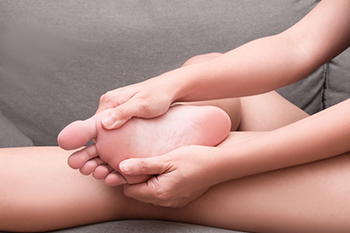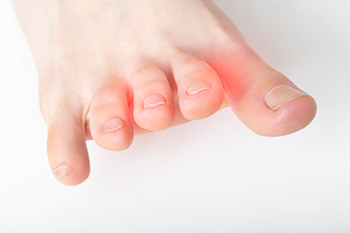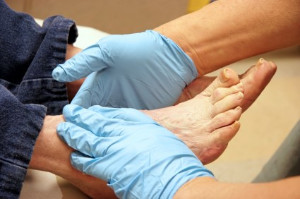Connect With Us
Blog

A common cause of foot pain is a condition known as sesamoiditis. It affects the sesamoid bones that are located inside of a tendon beneath the joint in the big toe. They are the only bones in the body that are connected to other bones through tendons instead of ligaments. They are known to absorb the weight of the body while walking, running, and jumping and can cause severe pain and discomfort if they become inflamed. This can happen as a result of participating in activities that can increase the pressure on the ball of the foot. The symptoms patients can experience may include difficulty in straightening or bending the big toe, in addition to bruising or swelling. The first step to relief is temporarily stopping the activity that caused the pain. It is suggested to refrain from wearing high-heeled shoes as well. If you have pain in this part of your foot, successful treatment starts with consulting a podiatrist who can help you manage this condition.
Sesamoiditis is an unpleasant foot condition characterized by pain in the balls of the feet. If you think you’re struggling with sesamoiditis, contact Dr. Richard Silverstein of Union Foot Care. Our doctor will treat your condition thoroughly and effectively.
Sesamoiditis
Sesamoiditis is a condition of the foot that affects the ball of the foot. It is more common in younger people than it is in older people. It can also occur with people who have begun a new exercise program, since their bodies are adjusting to the new physical regimen. Pain may also be caused by the inflammation of tendons surrounding the bones. It is important to seek treatment in its early stages because if you ignore the pain, this condition can lead to more serious problems such as severe irritation and bone fractures.
Causes of Sesamoiditis
- Sudden increase in activity
- Increase in physically strenuous movement without a proper warm up or build up
- Foot structure: those who have smaller, bonier feet or those with a high arch may be more susceptible
Treatment for sesamoiditis is non-invasive and simple. Doctors may recommend a strict rest period where the patient forgoes most physical activity. This will help give the patient time to heal their feet through limited activity. For serious cases, it is best to speak with your doctor to determine a treatment option that will help your specific needs.
If you have any questions please feel free to contact our office located in Havre de Grace, MD . We offer the newest diagnostic and treatment technologies for all your foot and ankle needs.

If you walk around feeling like you have a pebble in your shoe under the ball of the foot, you might have Morton’s neuroma. This is a thickening of the tissues next to nerves leading to the toe. Women are much more likely to suffer from this condition than men because they are more apt to wear high heels, which put pressure on the feet. Wearing shoes that are too tight or narrow may also lead to this uncomfortable foot ailment. Beyond feeling like there is a pebble under your foot, one can experience pain, burning, cramping, and/or numbness of the foot. Rest, foot stretching exercises to promote blood circulation, massaging the affected part of the foot, using shoe pads or orthotics to help absorb pressure, and wearing well fitting, flatter, supportive shoes should all help with irritation of a Morton’s neuroma. However, if you are having troubling symptoms for a prolonged time, it is suggested that you contact a podiatrist for proper diagnosis and a treatment plan.
Morton’s neuroma is a very uncomfortable condition to live with. If you think you have Morton’s neuroma, contact Dr. Richard Silverstein of Union Foot Care. Our doctor will attend to all of your foot care needs and answer any of your related questions.
Morton’s Neuroma
Morton's neuroma is a painful foot condition that commonly affects the areas between the second and third or third and fourth toe, although other areas of the foot are also susceptible. Morton’s neuroma is caused by an inflamed nerve in the foot that is being squeezed and aggravated by surrounding bones.
What Increases the Chances of Having Morton’s Neuroma?
- Ill-fitting high heels or shoes that add pressure to the toe or foot
- Jogging, running or any sport that involves constant impact to the foot
- Flat feet, bunions, and any other foot deformities
Morton’s neuroma is a very treatable condition. Orthotics and shoe inserts can often be used to alleviate the pain on the forefront of the feet. In more severe cases, corticosteroids can also be prescribed. In order to figure out the best treatment for your neuroma, it’s recommended to seek the care of a podiatrist who can diagnose your condition and provide different treatment options.
If you have any questions, please feel free to contact our office located in Havre de Grace, MD . We offer the newest diagnostic and treatment technologies for all your foot care needs.

If you walk around feeling like you have a pebble in your shoe under the ball of the foot, you might have Morton’s neuroma. This is a thickening of the tissues next to nerves leading to the toe. Women are much more likely to suffer from this condition than men because they are more apt to wear high heels, which put pressure on the feet. Wearing shoes that are too tight or narrow may also lead to this uncomfortable foot ailment. Beyond feeling like there is a pebble under your foot, one can experience pain, burning, cramping, and/or numbness of the foot. Rest, foot stretching exercises to promote blood circulation, massaging the affected part of the foot, using shoe pads or orthotics to help absorb pressure, and wearing well fitting, flatter, supportive shoes should all help with irritation of a Morton’s neuroma. However, if you are having troubling symptoms for a prolonged time, it is suggested that you contact a podiatrist for proper diagnosis and a treatment plan.
Morton’s neuroma is a very uncomfortable condition to live with. If you think you have Morton’s neuroma, contact Dr. Richard Silverstein of Union Foot Care. Our doctor will attend to all of your foot care needs and answer any of your related questions.
Morton’s Neuroma
Morton's neuroma is a painful foot condition that commonly affects the areas between the second and third or third and fourth toe, although other areas of the foot are also susceptible. Morton’s neuroma is caused by an inflamed nerve in the foot that is being squeezed and aggravated by surrounding bones.
What Increases the Chances of Having Morton’s Neuroma?
- Ill-fitting high heels or shoes that add pressure to the toe or foot
- Jogging, running or any sport that involves constant impact to the foot
- Flat feet, bunions, and any other foot deformities
Morton’s neuroma is a very treatable condition. Orthotics and shoe inserts can often be used to alleviate the pain on the forefront of the feet. In more severe cases, corticosteroids can also be prescribed. In order to figure out the best treatment for your neuroma, it’s recommended to seek the care of a podiatrist who can diagnose your condition and provide different treatment options.
If you have any questions, please feel free to contact our office located in Havre de Grace, MD . We offer the newest diagnostic and treatment technologies for all your foot care needs.

It is crucial for diabetic patients to check and manage their glucose levels daily, despite the time it can take from completing daily activities. The feet can typically be at risk in people who have diabetes, and this can be a result of the inability to feel sensations related to the feet. It is important to look for existing cuts, bruises, or scrapes. Some patients prefer to use a mirror to look at the sole of the foot. Diabetic foot care begins with washing and drying the feet daily, followed by using a good moisturizer on the entire foot except for the toes. It is common for diabetic patients to have poor circulation, and this can make it difficult for sores on the foot to heal. Foot ulcers are cuts or wounds on the feet that have become infected, and must be treated immediately to avoid possible gangrene. If you are diabetic, it is strongly suggested that you are under the care of a podiatrist who properly treats and offers helpful management tips.
Diabetic foot care is important in preventing foot ailments such as ulcers. If you are suffering from diabetes or have any other concerns about your feet, contact Dr. Richard Silverstein from Union Foot Care. Our doctor can provide the care you need to keep you pain-free and on your feet.
Diabetic Foot Care
Diabetes affects millions of people every year. The condition can damage blood vessels in many parts of the body, especially the feet. Because of this, taking care of your feet is essential if you have diabetes, and having a podiatrist help monitor your foot health is highly recommended.
The Importance of Caring for Your Feet
- Routinely inspect your feet for bruises or sores.
- Wear socks that fit your feet comfortably.
- Wear comfortable shoes that provide adequate support.
Patients with diabetes should have their doctor monitor their blood levels, as blood sugar levels play such a huge role in diabetic care. Monitoring these levels on a regular basis is highly advised.
It is always best to inform your healthcare professional of any concerns you may have regarding your feet, especially for diabetic patients. Early treatment and routine foot examinations are keys to maintaining proper health, especially because severe complications can arise if proper treatment is not applied.
If you have any questions please feel free to contact our office located in Havre de Grace, MD . We offer the newest diagnostic and treatment technologies for all your foot and ankle needs.
Blog Archives
- May 2024
- April 2024
- March 2024
- February 2024
- January 2024
- December 2023
- November 2023
- October 2023
- September 2023
- August 2023
- July 2023
- June 2023
- May 2023
- April 2023
- March 2023
- February 2023
- January 2023
- December 2022
- November 2022
- October 2022
- September 2022
- August 2022
- July 2022
- June 2022
- May 2022
- April 2022
- March 2022
- February 2022
- January 2022
- December 2021
- November 2021
- October 2021
- September 2021
- August 2021
- July 2021
- June 2021
- May 2021
- April 2021
- March 2021
- February 2021
- January 2021
- December 2020
- November 2020
- October 2020
- September 2020
- August 2020
- July 2020
- June 2020
- May 2020
- April 2020
- March 2020
- February 2020
- January 2020
- December 2019
- November 2019
- October 2019
- September 2019
- August 2019
- July 2019
- June 2019
- May 2019
- April 2019
- March 2019
- February 2019
- January 2019
- December 2018
- November 2018
- October 2018
- September 2018
- August 2018
- July 2018
- June 2018
- May 2018
- April 2018
- March 2018
- February 2018
- January 2018
- December 2017
- November 2017
- October 2017
- September 2017
- August 2017
- July 2017
- June 2017
- May 2017
- April 2017
- March 2017
- February 2017
- January 2017
- December 2016
- November 2016
- October 2016
- September 2016
- August 2016
- July 2016
- June 2016
- May 2016
